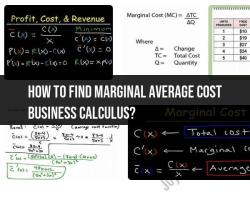How to find marginal average cost Business Calculus?
To find the marginal average cost in business calculus, you'll need to understand the concepts of marginal cost and average cost. The marginal cost represents the additional cost incurred by producing one more unit of a product, while the average cost represents the total cost per unit. The marginal average cost is the change in the average cost when producing one more unit. Here's how you can calculate it:
Calculate the Average Cost (AC):
To find the average cost, you need to divide the total cost (TC) by the quantity of units produced (Q). The formula for average cost is:
Calculate the Total Cost for the Current Quantity (TC1):
- Calculate the total cost for the current quantity (Q1) of units produced. This is the cost of producing Q1 units.
Calculate the Total Cost for One More Unit (TC2):
- Calculate the total cost for producing one more unit (Q1 + 1) of the product. This represents the cost incurred by increasing production by one unit.
Calculate the Average Cost for Q1 + 1 Units (AC2):
- Using the formula for average cost, calculate the average cost for producing Q1 + 1 units, which is the new total cost (TC2) divided by the new quantity (Q1 + 1).
Find the Marginal Average Cost (MAC):
The marginal average cost is the change in average cost when producing one more unit. You can calculate it as the difference between the average cost for Q1 + 1 units (AC2) and the average cost for Q1 units (AC1):
The marginal average cost (MAC) represents the additional cost incurred when increasing production by one unit, relative to the average cost at the current level of production. It helps businesses understand the impact of producing one more unit on their cost structure.
It's essential to remember that marginal cost and average cost can vary with different levels of production and might not always follow the same pattern. In some cases, the marginal cost may be lower than the average cost (decreasing average cost), while in other cases, it may be higher (increasing average cost). Analyzing these cost relationships can be valuable for businesses in making production and pricing decisions.
How to calculate marginal average cost in Business Calculus?
Marginal average cost is the change in total average cost that results from producing one additional unit of output. It is calculated using the following formula:
Marginal average cost = (Change in total average cost) / (Change in quantity)
Marginal average cost can be used to identify the most efficient level of production and to make pricing decisions. It can also be used to determine whether or not to produce a particular product or service.
What are the methods and formulas for determining marginal average cost in business analysis?
There are two main methods for determining marginal average cost in business analysis:
- The marginal cost approach: This approach involves calculating the marginal cost of producing each additional unit of output and then averaging the marginal costs.
- The total cost approach: This approach involves calculating the total cost of producing each additional unit of output and then dividing the total cost by the quantity produced.
The following formula can be used to calculate marginal average cost using the marginal cost approach:
Marginal average cost = (Marginal cost of producing the first unit) + (Marginal cost of producing the second unit) + ... + (Marginal cost of producing the last unit) / Number of units produced
The following formula can be used to calculate marginal average cost using the total cost approach:
Marginal average cost = (Total cost of producing the first unit) + (Total cost of producing the second unit) + ... + (Total cost of producing the last unit) / Number of units produced
How to apply the concept of marginal cost to optimize business decisions?
The concept of marginal cost can be applied to optimize business decisions in a number of ways. For example, businesses can use marginal cost to:
- Identify the most efficient level of production: Businesses can use marginal cost to identify the level of production at which the marginal cost of producing an additional unit of output is equal to the marginal revenue from selling that unit of output. This level of production is known as the profit-maximizing level of production.
- Make pricing decisions: Businesses can use marginal cost to set prices that are above the marginal cost of producing and selling a unit of output. This will ensure that the business is making a profit on each unit sold.
- Determine whether or not to produce a particular product or service: Businesses can use marginal cost to determine whether or not to produce a particular product or service by comparing the marginal cost of producing the product or service to the marginal revenue from selling the product or service. If the marginal revenue is greater than the marginal cost, the business should produce the product or service. If the marginal revenue is less than the marginal cost, the business should not produce the product or service.
By applying the concept of marginal cost, businesses can make more informed and profitable decisions.


